It looks like you're using an Ad Blocker.
Please white-list or disable AboveTopSecret.com in your ad-blocking tool.
Thank you.
Some features of ATS will be disabled while you continue to use an ad-blocker.
share:
reply to post by MegaMind
Yea most doctors are useless and i avoid them unless i have broken bones. My mother has had an infection in her throat off and on for years and it started back up. She went to see the doc, he came in the room for 10 seconds, looked at her throat, and told her to gargle w salt water. No anti-biotics. She couldnt even chant with him about anything else, shesaid it was like a meat market and he's just a numbers guy trying to see as much patients as possible and could care less about how ur really doing
Yea most doctors are useless and i avoid them unless i have broken bones. My mother has had an infection in her throat off and on for years and it started back up. She went to see the doc, he came in the room for 10 seconds, looked at her throat, and told her to gargle w salt water. No anti-biotics. She couldnt even chant with him about anything else, shesaid it was like a meat market and he's just a numbers guy trying to see as much patients as possible and could care less about how ur really doing
wow.... since I've yet to receive all of my equipment... I am now at a loss as to which type to try!?!? The Mathman's version of the yogurt
thickness with less water or the original????....
OMGeeeee... So much to ponder Please keep up the kind work of letting us know how you are feeling. And especially when you make the new, thicker batches!!
Dominicus, I was wondering if your dosage has remained the same throughout the time you have been using this V-C or if you have had to increase as time went on? Also, how long have you been using it?
I'm going to re-read your OP, and see if I missed the answers, so if you answered in the OP, then no need to reiterate!
Stoked!!
OMGeeeee... So much to ponder Please keep up the kind work of letting us know how you are feeling. And especially when you make the new, thicker batches!!
Dominicus, I was wondering if your dosage has remained the same throughout the time you have been using this V-C or if you have had to increase as time went on? Also, how long have you been using it?
I'm going to re-read your OP, and see if I missed the answers, so if you answered in the OP, then no need to reiterate!
Stoked!!
Here's some info from my experiments of the quantities I made:
2 tbsp of lecithin added to 1 cup of water blended for 3 minutes+ 1 tbsp of ascorbic acid added to 1 cup of water blended for a total of 5 minutes resulted in no lumps or residual lecithin, looked like
Milk with minimum foam. However this caused the diarrhea I believe.
2 tbsp of lecithin to 1 cup water blended for 4 minutes + 1 tbsp of ascorbic acid to half cup water blended for total of 6 minutes, milky consistency with no residue. No side effects.
3 tbsp of lecithin to 1 cup of water blended for 2 minutes + 1 tbsp of ascorbic acid in half cup of water blended for total of 3 minutes. The mix is 50-50 milky looking water and the the other half is lecithin clumps or residue, once the jar is shaken the dose is great, had a dose this morning while mixture is settled and had no real effect.
I'm going to make the 3rd mixture again today, but I'm going to bled the lecithin for about 4 minutes after a 15 minute soak, then I'll add the acid and then blend for another minute. Should get creamy consistency.
2 tbsp of lecithin added to 1 cup of water blended for 3 minutes+ 1 tbsp of ascorbic acid added to 1 cup of water blended for a total of 5 minutes resulted in no lumps or residual lecithin, looked like
Milk with minimum foam. However this caused the diarrhea I believe.
2 tbsp of lecithin to 1 cup water blended for 4 minutes + 1 tbsp of ascorbic acid to half cup water blended for total of 6 minutes, milky consistency with no residue. No side effects.
3 tbsp of lecithin to 1 cup of water blended for 2 minutes + 1 tbsp of ascorbic acid in half cup of water blended for total of 3 minutes. The mix is 50-50 milky looking water and the the other half is lecithin clumps or residue, once the jar is shaken the dose is great, had a dose this morning while mixture is settled and had no real effect.
I'm going to make the 3rd mixture again today, but I'm going to bled the lecithin for about 4 minutes after a 15 minute soak, then I'll add the acid and then blend for another minute. Should get creamy consistency.
I cooked up a batch this evening, milky, smooth texture, not much taste. Compared to the store bought stuff it is more liquid. I occurs to the me that
the packets I purchased have removed the water for shipping and handling. I'm not sure the texture matters much, only the amount present. If one can
easily take the 1 oz of home made it should be no issue, the packets are nice for traveling and stocking.
On a really out there suggestion. While stirring, it occurred to me that if one could get the machine to vibrate at the 528 hz frequency you'd get your socks blown off. This frequency heals dna and would be imparted in the mixture. I have no idea how to alter the machine, but am open.
On a really out there suggestion. While stirring, it occurred to me that if one could get the machine to vibrate at the 528 hz frequency you'd get your socks blown off. This frequency heals dna and would be imparted in the mixture. I have no idea how to alter the machine, but am open.
Like all geniuses, Linus Pauling was hated by a lot of his peers who tried to sabotage his research and conclusions. If high doses of Vitamin C cause
cancer, why then don't all the other animals that literally flood their tissues with Vitamin C every minute of every day get more cancers? Do the
great apes get colds? It'd be a fun question to ask a zookeeper, or Jane Goodall. I know my dogs and cats have never had a cold except one poor
kitty who inhaled a lot of catnip dust.
Regarding M.D.'s, it took me 30 years in the medical field to find something out; if a person has an M.D. after their name, they are prohibited by law, subject to losing their medical licenses, if they 'recommend' a non FDA approved drug or supplement; their options are to either write a prescription for something, cut you with a scalpel or adopt the 'wait and see' approach which works great a goodly percentage of the time. If they want you to take an aspirin, they have to write a script for it; they can't tell you to go buy aspirin over the counter and take it. That's what being an M.D. in America means; it's a prohibitively narrow take on achieving and maintaining health and the reaction to people like Pauling shows what happens to people who step away from the company line...The ones that are open minded and willing to recommend non-FDA approved meds, supplements and herbs are taking a big chance. The medical advancements are not made by the status quo bunch.
Know what docs call their 'cure' for cancer? Slash and burn, which is exactly what it is. You can bet that a lot of the docs, especially the ones in the top of their classes and not arrogant, when they or their family gets a diagnosis of something serious, they use all the possible solutions out there, not just the peer reviewed crap, because they know by definition research takes years and is dependent on big pharma money to happen at all. Keep in mind that half of all docs graduated in the bottom half of their classes, and partied their way through college to a great extent. The ones that do 'continuing ed' of a true open minded nature are rare indeed.
Regarding M.D.'s, it took me 30 years in the medical field to find something out; if a person has an M.D. after their name, they are prohibited by law, subject to losing their medical licenses, if they 'recommend' a non FDA approved drug or supplement; their options are to either write a prescription for something, cut you with a scalpel or adopt the 'wait and see' approach which works great a goodly percentage of the time. If they want you to take an aspirin, they have to write a script for it; they can't tell you to go buy aspirin over the counter and take it. That's what being an M.D. in America means; it's a prohibitively narrow take on achieving and maintaining health and the reaction to people like Pauling shows what happens to people who step away from the company line...The ones that are open minded and willing to recommend non-FDA approved meds, supplements and herbs are taking a big chance. The medical advancements are not made by the status quo bunch.
Know what docs call their 'cure' for cancer? Slash and burn, which is exactly what it is. You can bet that a lot of the docs, especially the ones in the top of their classes and not arrogant, when they or their family gets a diagnosis of something serious, they use all the possible solutions out there, not just the peer reviewed crap, because they know by definition research takes years and is dependent on big pharma money to happen at all. Keep in mind that half of all docs graduated in the bottom half of their classes, and partied their way through college to a great extent. The ones that do 'continuing ed' of a true open minded nature are rare indeed.
Originally posted by signalfire
Like all geniuses, Linus Pauling was hated by a lot of his peers who tried to sabotage his research and conclusions. If high doses of Vitamin C cause cancer, why then don't all the other animals that literally flood their tissues with Vitamin C every minute of every day get more cancers? Do the great apes get colds? It'd be a fun question to ask a zookeeper, or Jane Goodall. I know my dogs and cats have never had a cold except one poor kitty who inhaled a lot of catnip dust.
Regarding M.D.'s, it took me 30 years in the medical field to find something out; if a person has an M.D. after their name, they are prohibited by law, subject to losing their medical licenses, if they 'recommend' a non FDA approved drug or supplement; their options are to either write a prescription for something, cut you with a scalpel or adopt the 'wait and see' approach which works great a goodly percentage of the time. If they want you to take an aspirin, they have to write a script for it; they can't tell you to go buy aspirin over the counter and take it. That's what being an M.D. in America means; it's a prohibitively narrow take on achieving and maintaining health and the reaction to people like Pauling shows what happens to people who step away from the company line...The ones that are open minded and willing to recommend non-FDA approved meds, supplements and herbs are taking a big chance. The medical advancements are not made by the status quo bunch.
Know what docs call their 'cure' for cancer? Slash and burn, which is exactly what it is. You can bet that a lot of the docs, especially the ones in the top of their classes and not arrogant, when they or their family gets a diagnosis of something serious, they use all the possible solutions out there, not just the peer reviewed crap, because they know by definition research takes years and is dependent on big pharma money to happen at all. Keep in mind that half of all docs graduated in the bottom half of their classes, and partied their way through college to a great extent. The ones that do 'continuing ed' of a true open minded nature are rare indeed.
This is true, one also needs to consider that despite what science demands we believe, humans are not mice.
Hi OP/ALL,
CHRONIC ACQUIRED IRON OVERLOAD -
For those asking about SAFETY...
vitamin C and other acidic substances like tomatoes can increase iron absorption. Vitamin C can lower copper significantly, causing very severe problems in some people if used repeatedly.
drlwilson.com...
VERY INTERESTING ESSENTIAL ARTICLE FOR ALL IN ITS OWN RIGHT - but don't let it put you off the Liposomal Vitamin C just be aware of the possibility of it - iron overload.
drlwilson.com...
...................................................................................................................................
A hair tissue mineral analysis (HTMA) simply stated, is a screening test that measures the mineral content of your hair. However, a hair tissue mineral analysis is much more than a test for minerals.
Benefits of Hair Tissue Mineral Analysis
Hair analysis can identify:
Trace element deficiencies
Trends for psychological and emotional conditions
Heavy metal toxicity
Cellular energy levels
Glucose tolerance
Kidney and liver stress
Adrenal and thyroid activity
Trends for over 30 health conditions
Which foods and nutritional supplements are right for you
Mineral Blueprint
Providing a mineral blueprint of one’s biochemistry, a hair tissue mineral analysis can provide pertinent information about your metabolic rate, energy levels, sugar and carbohydrate tolerance, stage of stress, immune system and glandular activity.
A hair tissue mineral analysis is a screening test for the level of 20 minerals and toxic metals in a sample of hair. It is a tissue mineral biopsy that is non-invasive, relatively inexpensive and extremely accurate.
A hair tissue mineral analysis is considered a standard test used around the world for the biological monitoring of trace elements and toxic metals in humans and animals. The same technology is used for soil testing and testing of rock samples to detect mineral levels.
Hair, like all other body tissues, contains minerals that are deposited as the hair grows. Although the hair is dead, the minerals remain as the hair continues to grow out. A sample of hair cut close to the scalp provides information about the mineral activity in the hair that took place over the past three to four months, depending on the rate of hair growth.
Why Use Hair?
Hair makes an excellent biopsy because:
Sampling is simple.
Mineral levels in the hair are ten times that of the blood, making them easy to detect in the hair.
The hair provides a cellular reading of the mineral levels. The cells are the major site of metabolic activity in the body.
......................................................................
A regime for taking Regular Vit C --
In the morning I will mix a level teaspoon (3 grams) of sodium ascorbate with the same amount of MSM.
I drink this immediately. Then I place 1 teaspoon of sodium ascorbate (about 5 to 6 grams) into a drink bottle and sip on this over the day. This gives me about 8 to 9 grams of sodium ascorbate each day, and the MSM ramps up the absorption and utilization of the C by a huge amount. I would hope to have 4 to 5 grams in my blood each day. The chelation effect is very good so I need to make sure I take a good quality multi mineral to make up for the chelation effects of the C. I break from this routine over weekends so my body doesn't get lazy. Another variation is to add sodium bicarbonate (aluminum free) to ascorbic acid instead of sodium ascorbate which makes the "C" sodium ascorbate, with enough extra sodium bicarbonate to do its thing, plus the MSM to enhance the "C" for longer and more enhanced life. Start by adding a quarter of a teaspoon of sodium bicarbonate to each heaped teaspoon of ascorbic acid and gradually build the dose to about half a teaspoon. I also add a heaping teaspoon of MSM (e.g. MethylSulfonylMethane from Rich Distributing as powder) to each dose and take this combination twice a day.
CHRONIC ACQUIRED IRON OVERLOAD -
A DISEASE OF CIVILIZATION
For those asking about SAFETY...
vitamin C and other acidic substances like tomatoes can increase iron absorption. Vitamin C can lower copper significantly, causing very severe problems in some people if used repeatedly.
drlwilson.com...
VERY INTERESTING ESSENTIAL ARTICLE FOR ALL IN ITS OWN RIGHT - but don't let it put you off the Liposomal Vitamin C just be aware of the possibility of it - iron overload.
drlwilson.com...
...................................................................................................................................
What is Hair Tissue Mineral Analysis?
A hair tissue mineral analysis (HTMA) simply stated, is a screening test that measures the mineral content of your hair. However, a hair tissue mineral analysis is much more than a test for minerals.
Benefits of Hair Tissue Mineral Analysis
Hair analysis can identify:
Trace element deficiencies
Trends for psychological and emotional conditions
Heavy metal toxicity
Cellular energy levels
Glucose tolerance
Kidney and liver stress
Adrenal and thyroid activity
Trends for over 30 health conditions
Which foods and nutritional supplements are right for you
Mineral Blueprint
Providing a mineral blueprint of one’s biochemistry, a hair tissue mineral analysis can provide pertinent information about your metabolic rate, energy levels, sugar and carbohydrate tolerance, stage of stress, immune system and glandular activity.
A hair tissue mineral analysis is a screening test for the level of 20 minerals and toxic metals in a sample of hair. It is a tissue mineral biopsy that is non-invasive, relatively inexpensive and extremely accurate.
A hair tissue mineral analysis is considered a standard test used around the world for the biological monitoring of trace elements and toxic metals in humans and animals. The same technology is used for soil testing and testing of rock samples to detect mineral levels.
Hair, like all other body tissues, contains minerals that are deposited as the hair grows. Although the hair is dead, the minerals remain as the hair continues to grow out. A sample of hair cut close to the scalp provides information about the mineral activity in the hair that took place over the past three to four months, depending on the rate of hair growth.
Why Use Hair?
Hair makes an excellent biopsy because:
Sampling is simple.
Mineral levels in the hair are ten times that of the blood, making them easy to detect in the hair.
The hair provides a cellular reading of the mineral levels. The cells are the major site of metabolic activity in the body.
......................................................................
A regime for taking Regular Vit C --
In the morning I will mix a level teaspoon (3 grams) of sodium ascorbate with the same amount of MSM.
I drink this immediately. Then I place 1 teaspoon of sodium ascorbate (about 5 to 6 grams) into a drink bottle and sip on this over the day. This gives me about 8 to 9 grams of sodium ascorbate each day, and the MSM ramps up the absorption and utilization of the C by a huge amount. I would hope to have 4 to 5 grams in my blood each day. The chelation effect is very good so I need to make sure I take a good quality multi mineral to make up for the chelation effects of the C. I break from this routine over weekends so my body doesn't get lazy. Another variation is to add sodium bicarbonate (aluminum free) to ascorbic acid instead of sodium ascorbate which makes the "C" sodium ascorbate, with enough extra sodium bicarbonate to do its thing, plus the MSM to enhance the "C" for longer and more enhanced life. Start by adding a quarter of a teaspoon of sodium bicarbonate to each heaped teaspoon of ascorbic acid and gradually build the dose to about half a teaspoon. I also add a heaping teaspoon of MSM (e.g. MethylSulfonylMethane from Rich Distributing as powder) to each dose and take this combination twice a day.
edit on 7-6-2012 by neotech1neothink because:
Disregard my previous posts. The atomizer doesnt create the same effect. Im going to buy one of the ultrasonic cleaners.
Everyone has been questioning whether or not encapsulation has occurred. someone was posting about bowel movements. lol
I can taste the vitamin C when its not encased in the lipid. You shouldnt taste the sweet tart taste of the Vit C, if your process has worked.
Everyone has been questioning whether or not encapsulation has occurred. someone was posting about bowel movements. lol
I can taste the vitamin C when its not encased in the lipid. You shouldnt taste the sweet tart taste of the Vit C, if your process has worked.
reply to post by signalfire
I'm sorry, but Linus Pauling...hated? You have to be joking. So hated that he features in every single chemistry text book I can think of? So hated that he won not one, but 2 Nobel prizes (as well as multiple other prestigious awards) and managed to publish numerous books and papers on his work, not to mention the numerous books that people went on to write about him? So hated that he has been listed as one of history's top 20 scientists of the last century? So hated that Francis Crick, another very well known Nobel prize laureate, dubbed him as the 'father of molecular biology'?
Jesus, if only I were only half as 'hated'.
I'm sorry, but Linus Pauling...hated? You have to be joking. So hated that he features in every single chemistry text book I can think of? So hated that he won not one, but 2 Nobel prizes (as well as multiple other prestigious awards) and managed to publish numerous books and papers on his work, not to mention the numerous books that people went on to write about him? So hated that he has been listed as one of history's top 20 scientists of the last century? So hated that Francis Crick, another very well known Nobel prize laureate, dubbed him as the 'father of molecular biology'?
Jesus, if only I were only half as 'hated'.
Originally posted by shoeshiner
I'll change this because it sounds weird now that i think of it but anyway there was a guy with a similar problem and he used a glass bottle within the US or something like that, first reult when you google; liposomal vitamin c whiskey glass
Thanks for that. So I can just put any glass receptacle into the UC bin and it will work just the same? I suppose that is kind of obvious as it's US not electrical.
Originally posted by MegaMind
reply to post by Kharron
Your link and info come from Quackwatch ... not a big fan of that site ... generally they ridicule anything other than big pharma. Typical AMA crap.
Is the quack watch founder a quack himself?
The Quackery Behind Quackwatch ...
I'm not saying there isn't any truth to what he is reporting but just wanted you to know he has a big agenda ...
edit on 6-6-2012 by MegaMind because: (no reason given)
Absolutely, if it's on quackwatch it's probably misinformation or just made up garbage.
Good progress from members making it so far.
Maybe someday we can make it perfect and prove that it does work, and not just a hype over the feeling.
Megamind will you be interested in doing this with your variety of future mixes? You seem to be experimenting and we are lucky to have one like you.
www.racehorseherbal.com...
Maybe someday we can make it perfect and prove that it does work, and not just a hype over the feeling.
Megamind will you be interested in doing this with your variety of future mixes? You seem to be experimenting and we are lucky to have one like you.
www.racehorseherbal.com...
Brooks Bradley's simple test to gauge LET efficiency of a liposomal Vitamin C solution:
1) Pour 4 ounces of the finished LET Vitamin C into a 12oz container.
2) Add 1/4 teaspoon of sodium bicarbonate into 1 oz of distilled water, stirring well.
3) Pour the sodium bicarbonate solution into the LET Vitamin C mixture, stirring.
Results: If the resulting foam reaction line from this mixture is .5" or less you will have approximately a 50% encapsulation rate of the raw ascorbic acid nanoparticles. If the foam is 3/8" or less you will have approximately 60% encapsulation. If the foam is 1/8" thick or less, you will have around 75% encapsulation.
Foam occurs when the unencapsulated Vit C reacts with the sodium bicarbonate which is added to produce sodium ascorbate. The liposome encapsulated Vit C will not react. Thus, the less foam, the more Vit C is encapsulated and the more efficient went your process. By the way, this test solution should not be discarded as it is still valuable as a medicinal! The formed sodium ascorbate is a very useable form of Vitamin C.
Just making up my first batch so will post pix in a bit and results a bit later.
Been reading up on ultrasound as I am not impressed with this pathetic little UC I bought.
Here is a brief overview for those interested:
www.angelfire.com...
ETA: I took the plunge and ordered another USC:
www.ebay.co.uk...
this one says it is professional, stainless and has a 30 minute timer (I already got irritated with switching back again every 2 minutes!) It is also a bit more powerful at 70W. Same seller has 2 and 3 and 10 liter versions with much higher power
Been reading up on ultrasound as I am not impressed with this pathetic little UC I bought.
Here is a brief overview for those interested:
www.angelfire.com...
ETA: I took the plunge and ordered another USC:
www.ebay.co.uk...
this one says it is professional, stainless and has a 30 minute timer (I already got irritated with switching back again every 2 minutes!) It is also a bit more powerful at 70W. Same seller has 2 and 3 and 10 liter versions with much higher power
edit on 7-6-2012 by RogerT3 because: (no
reason given)
Procedure Used to make first batch
Ok, here we go.
Quantities:
Lecithin: 3 tablespoons (level) which is around 30g
Pure Ascorbic Acid Granules: 1 tablespoon (level) about 14g so ratio is 2:1 lecithin:ascorbic
this is the blender I used:
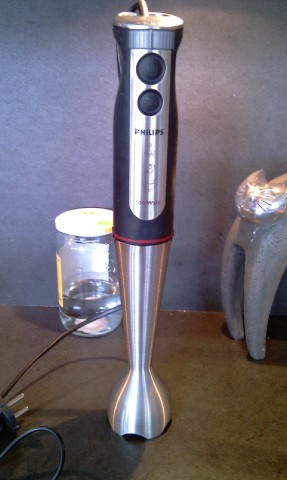
this is the USC with a glass insert (my DIY invention to avoid contact with the non-SS bowl):
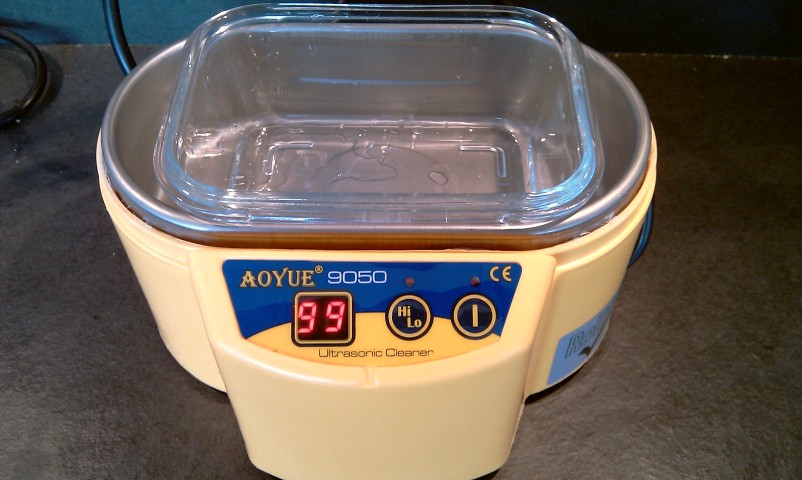
this is the lecithin powder after 10 mins in a jar with RO water (shaken a couple of times):

and after 20 mins:
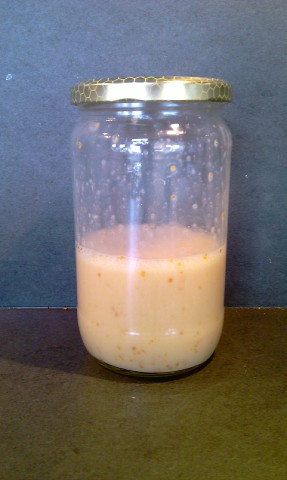
blended for 60 seconds:
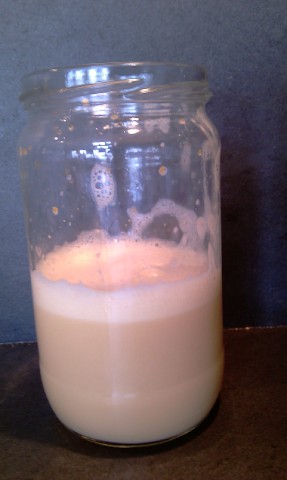
first pass of 99 seconds with USC:
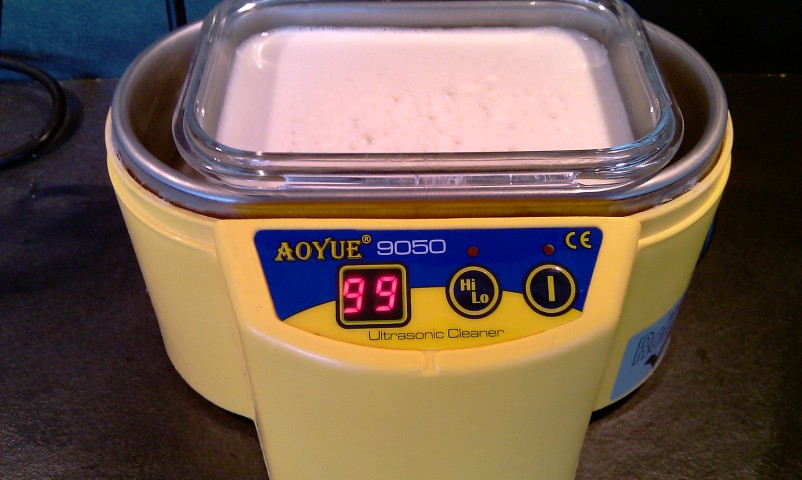
14th pass (although it seems this UC has an auto cut out when it gets warm, as it sometimes made no noise whilst on and other times it buzzed loudly! - so it's possible it was less than 14 passes):
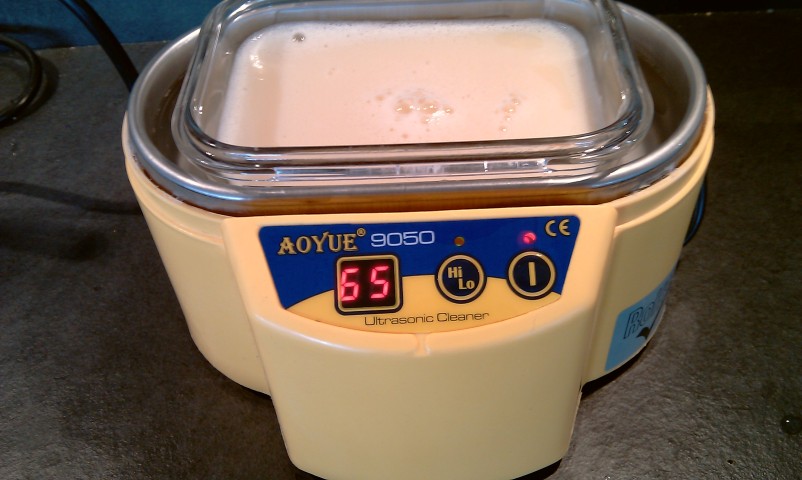
20th and final pass (about 30 mins) also a shot glass I will use for doses of 1 ounce:
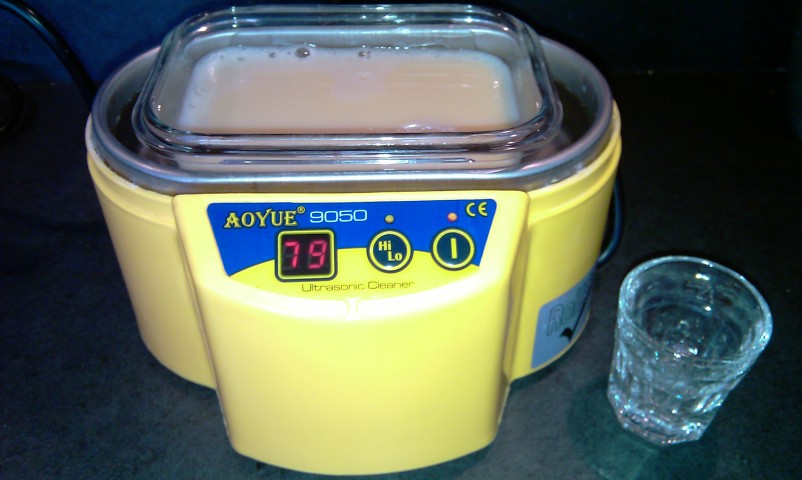
Here is a comparison between the mix that has been sonically cleaned (left) and the one that isn't (I couldn't fit it all in the glass insert.)
I also tested the pH with universal paper range 5.5 to 8 as my pH meter batteries are dead so accuracy will have to wait for next batch. pH of pre USC was 5.5 or less. After it looked a little higher, perhaps 6 however, it is very difficult to tell, so better wait on that for the electronic device!
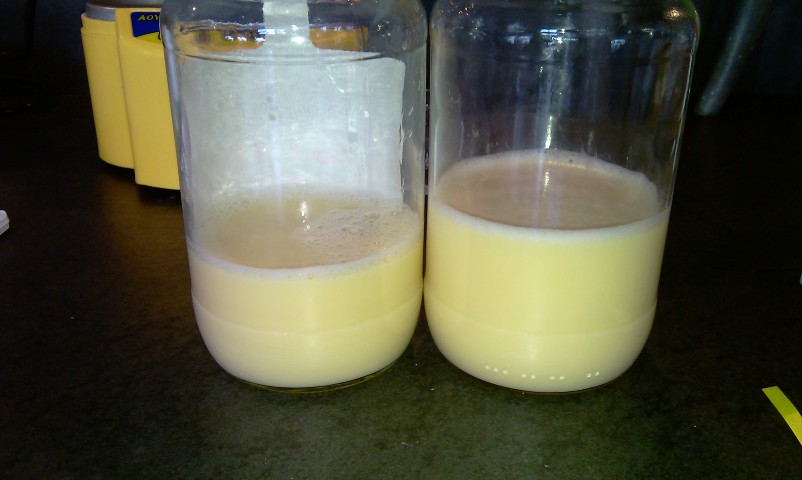
finally, I dumped the second half in the USC tray and ran it again:
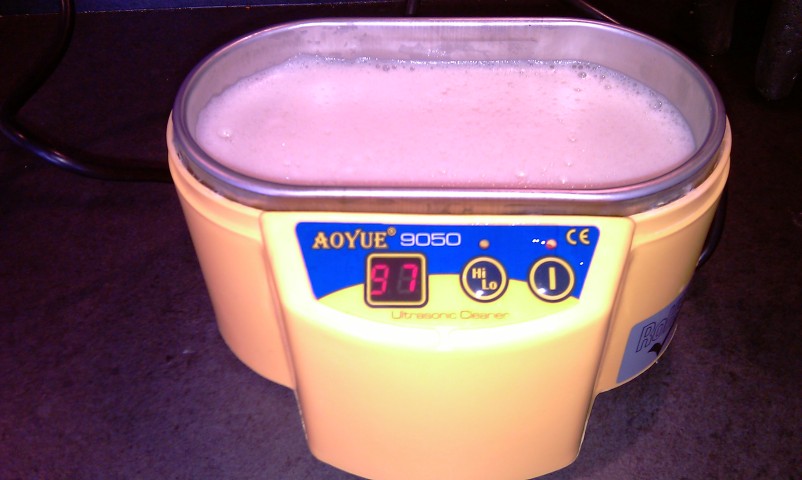
after only 10 passes the foam was similar to 20 on the previous, so again, this is either due to the insert, the unit shutting down when hot, or the foam is no measure of liposomal action!
I found if I shake up the final mixture it foams up again quite nicely, and even without the USC the foam dissipates after 30 mins, so my personal feeling is the foam is not a reliable measure of ANYTHING!!!!
I will post this now and then edit with more details
Ok, here we go.
Quantities:
Lecithin: 3 tablespoons (level) which is around 30g
Pure Ascorbic Acid Granules: 1 tablespoon (level) about 14g so ratio is 2:1 lecithin:ascorbic
this is the blender I used:

this is the USC with a glass insert (my DIY invention to avoid contact with the non-SS bowl):

this is the lecithin powder after 10 mins in a jar with RO water (shaken a couple of times):

and after 20 mins:

blended for 60 seconds:

first pass of 99 seconds with USC:

14th pass (although it seems this UC has an auto cut out when it gets warm, as it sometimes made no noise whilst on and other times it buzzed loudly! - so it's possible it was less than 14 passes):

20th and final pass (about 30 mins) also a shot glass I will use for doses of 1 ounce:

Here is a comparison between the mix that has been sonically cleaned (left) and the one that isn't (I couldn't fit it all in the glass insert.)
I also tested the pH with universal paper range 5.5 to 8 as my pH meter batteries are dead so accuracy will have to wait for next batch. pH of pre USC was 5.5 or less. After it looked a little higher, perhaps 6 however, it is very difficult to tell, so better wait on that for the electronic device!

finally, I dumped the second half in the USC tray and ran it again:

after only 10 passes the foam was similar to 20 on the previous, so again, this is either due to the insert, the unit shutting down when hot, or the foam is no measure of liposomal action!
I found if I shake up the final mixture it foams up again quite nicely, and even without the USC the foam dissipates after 30 mins, so my personal feeling is the foam is not a reliable measure of ANYTHING!!!!
I will post this now and then edit with more details
edit on 7-6-2012 by RogerT3 because: (no reason given)
edit on 7-6-2012 by
RogerT3 because: (no reason given)
My Personal Experience
I took a one ounce (30ml) of the mix I did in the glass insert.
Tasted sour and oily, not so bad but not particularly yummy either.
within a few minutes I had a bit of discomfort in the stomach and watery mouth, which is a typical reaction to say drinking a couple of juiced garlic cloves on an empty stomach - nothing significant
20 minutes I took a glass of water with lemon juice to try to remove the oily lecithin taste (didn't work much).
40 minutes a bit of stomach burn, but really nothing much. I've had much much worse with a glass of apple juice.
50 minutes I had a bowl of soup
Now 70 minutes in and I can report NO NOTICEABLE IMPROVEMENT so far in well being, clarity of mind or vision.
I'll report back in a few hours and take another ounce or two before dinner.
My batch of 16 ounces (half a liter) contains 14g of VitC, so I guess I am taking doses of just under a gram. I don't use non-food supps at all generally, other than herbal tinctures, however I've taken vitC before when I used to smoke a bit and felt the need for it. Back then I'd use the fizzy 1g tablets but never had any problems with them, so 1g wouldn't be all that noticeable anyway if it wasn't lipoC (in terms of body reaction). Since they started adding aspartame to ALL the fizzy vit tabs, I quit buying them and went with acerola. Again, never really experienced any noticeable effect.
Looking forward to continuing my experiment and hearing all the stories from the other wonderful peeps in this thread
I took a one ounce (30ml) of the mix I did in the glass insert.
Tasted sour and oily, not so bad but not particularly yummy either.
within a few minutes I had a bit of discomfort in the stomach and watery mouth, which is a typical reaction to say drinking a couple of juiced garlic cloves on an empty stomach - nothing significant
20 minutes I took a glass of water with lemon juice to try to remove the oily lecithin taste (didn't work much).
40 minutes a bit of stomach burn, but really nothing much. I've had much much worse with a glass of apple juice.
50 minutes I had a bowl of soup
Now 70 minutes in and I can report NO NOTICEABLE IMPROVEMENT so far in well being, clarity of mind or vision.
I'll report back in a few hours and take another ounce or two before dinner.
My batch of 16 ounces (half a liter) contains 14g of VitC, so I guess I am taking doses of just under a gram. I don't use non-food supps at all generally, other than herbal tinctures, however I've taken vitC before when I used to smoke a bit and felt the need for it. Back then I'd use the fizzy 1g tablets but never had any problems with them, so 1g wouldn't be all that noticeable anyway if it wasn't lipoC (in terms of body reaction). Since they started adding aspartame to ALL the fizzy vit tabs, I quit buying them and went with acerola. Again, never really experienced any noticeable effect.
Looking forward to continuing my experiment and hearing all the stories from the other wonderful peeps in this thread
edit on 7-6-2012 by
RogerT3 because: (no reason given)
reply to post by shoeshiner
The link you provided is a very interesting read. They describe the gelatinous layer that forms when having more lethicin present - just like that video on the previous page.
The writer seems very knowledgeable ...
link ...
Fantastic! I will try this test on my batch and post my results ...
The link you provided is a very interesting read. They describe the gelatinous layer that forms when having more lethicin present - just like that video on the previous page.
The writer seems very knowledgeable ...
link ...
Lecithin is slow in forming liposomes in aqueous solutions especially when one has not added correct amount ratios of lecithin to the pharmacological solution to be encapsulated. It is often natural to find a gelatinous mass of unencapsulated Lecithin floating on top of your LET solution. The encapsulation process is affected by amount ratios, temperatures of the solutions, and concentrations of the components. One can limit this unencapsulated lecithin layer by increasing the volume of the total water though this has a diluting effect in the combined solution and/or raising the temperature of the solution. Increasing the ultrasonic mixing cycle may also be of value. It should be noted that once the saturation point has been reached in the solution, no amount of adjusting will cause the lecithin to continue to encapsulate. The guiding line for the amateur LET processor is that it is far better to have a layer of unencapsulated lecithin than to produce a solution with too little, no matter how pretty the final solution may look.
Brooks Bradley's simple test to gauge LET efficiency of a liposomal Vitamin C solution:
1) Pour 4 ounces of the finished LET Vitamin C into a 12oz container.
2) Add 1/4 teaspoon of sodium bicarbonate into 1 oz of distilled water, stirring well.
3) Pour the sodium bicarbonate solution into the LET Vitamin C mixture, stirring.
Results: If the resulting foam reaction line from this mixture is .5" or less you will have approximately a 50% encapsulation rate of the raw ascorbic acid nanoparticles. If the foam is 3/8" or less you will have approximately 60% encapsulation. If the foam is 1/8" thick or less, you will have around 75% encapsulation.
Foam occurs when the unencapsulated Vit C reacts with the sodium bicarbonate which is added to produce sodium ascorbate. The liposome encapsulated Vit C will not react. Thus, the less foam, the more Vit C is encapsulated and the more efficient went your process. By the way, this test solution should not be discarded as it is still valuable as a medicinal! The formed sodium ascorbate is a very useable form of Vitamin C.
Fantastic! I will try this test on my batch and post my results ...
edit on 7-6-2012 by MegaMind because: (no reason given)
The Test ...
link ...
The Setup ...

The Results ...
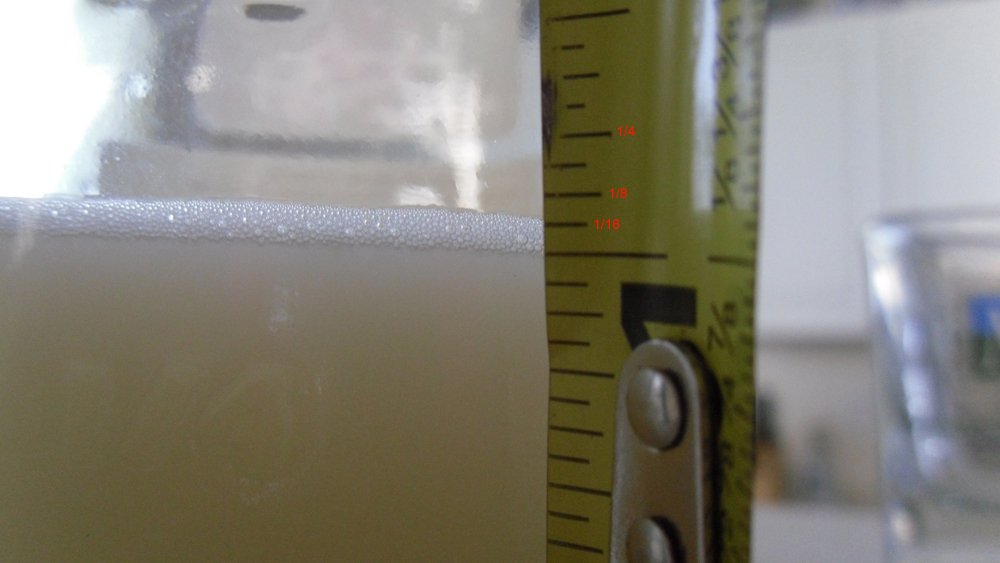
As you can see about a 1/16th of an inch ...
So according to the test I have at least 75% encapsulated Liposomal C.
My Conclusion ...
Bottom line is the C is encapsulated protecting it from the baking soda solution and preventing an acid / alkaline reaction. Only the unencapsulated C is reacting with the soda ...
I would also like to add that my experiment yesterday of taking 3oz at one time, 3000mg of C, never did result in diarrhea or even a lose stool. Anyone that has been taking C supplements knows that the limit to how many C pills or how much C powder you can take at one time is limited by diarrhea. In my case that is about 1000mg of C at once. If this weren't the case you could take as much C orally as you wanted. But no one can.
My experiment yesterday of taking 3 oz plus the results of this test make me very confident that this homemade brew is indeed Liposomal C. The results speak for themselves.
link ...
Brooks Bradley's simple test to gauge LET efficiency of a liposomal Vitamin C solution:
1) Pour 4 ounces of the finished LET Vitamin C into a 12oz container.
2) Add 1/4 teaspoon of sodium bicarbonate into 1 oz of distilled water, stirring well.
3) Pour the sodium bicarbonate solution into the LET Vitamin C mixture, stirring.
Results: If the resulting foam reaction line from this mixture is .5" or less you will have approximately a 50% encapsulation rate of the raw ascorbic acid nanoparticles. If the foam is 3/8" or less you will have approximately 60% encapsulation. If the foam is 1/8" thick or less, you will have around 75% encapsulation.
Foam occurs when the unencapsulated Vit C reacts with the sodium bicarbonate which is added to produce sodium ascorbate. The liposome encapsulated Vit C will not react. Thus, the less foam, the more Vit C is encapsulated and the more efficient went your process. By the way, this test solution should not be discarded as it is still valuable as a medicinal! The formed sodium ascorbate is a very useable form of Vitamin C.
The Setup ...

The Results ...

As you can see about a 1/16th of an inch ...
So according to the test I have at least 75% encapsulated Liposomal C.
My Conclusion ...
Bottom line is the C is encapsulated protecting it from the baking soda solution and preventing an acid / alkaline reaction. Only the unencapsulated C is reacting with the soda ...
I would also like to add that my experiment yesterday of taking 3oz at one time, 3000mg of C, never did result in diarrhea or even a lose stool. Anyone that has been taking C supplements knows that the limit to how many C pills or how much C powder you can take at one time is limited by diarrhea. In my case that is about 1000mg of C at once. If this weren't the case you could take as much C orally as you wanted. But no one can.
My experiment yesterday of taking 3 oz plus the results of this test make me very confident that this homemade brew is indeed Liposomal C. The results speak for themselves.
edit on 7-6-2012 by MegaMind because: (no reason given)
edit on 7-6-2012 by MegaMind because: (no reason given)
reply to post by MegaMind
Thanks, I was very curious to see someone finally do that test. Looks like success for you.
Thanks, I was very curious to see someone finally do that test. Looks like success for you.
Since I got good results I will recap the method I used for those interested ...
First my Vitamin C powder is 5000mg per teaspoon ...
Second my Lecithin (been spelling it wrong ) is 1680mg per tablespoon ...
I measured 3 level tablespoons of granular Lecithin and mixed it with a spoon in one cup of distilled water ...
Let the lecithin soak for at least 30 minutes ...
Then I measured 1 level tablespoon of vitamin C powder and mixed it with a spoon into 1 cup of distilled water dissolving it completely ...
Then I took the lecithin solution and put it in a blender on high for 1 minute ...
Next I poured the vitamin C solution into the blender and blended on high for 20 seconds ...
Finally I poured the mixture into my stainless steel jewelry cleaner (from Harbor Freight Tools) and ran the cycles, stirring frequently, until all the foam was gone (long time 30+ minutes) ...
The results are an oily sour tasting solution that has a consistency of watery milk and looks like it too. It has maybe the slightest bit of an orange to yellow hue.
The total volume of solution is 2 cups. The total C in the solution is 15,000mg. At a 1 oz dose there are 16 doses in this recipe. Each dose has 937mg of C with at about 700mg encapsulated. At an 80% absorption rate in the body you should get 560mg of C per dose.
Compare that to 1000mg of C in pills at 16% absorption for 160mg of C.
Good luck to all!
First my Vitamin C powder is 5000mg per teaspoon ...
Second my Lecithin (been spelling it wrong ) is 1680mg per tablespoon ...
I measured 3 level tablespoons of granular Lecithin and mixed it with a spoon in one cup of distilled water ...
Let the lecithin soak for at least 30 minutes ...
Then I measured 1 level tablespoon of vitamin C powder and mixed it with a spoon into 1 cup of distilled water dissolving it completely ...
Then I took the lecithin solution and put it in a blender on high for 1 minute ...
Next I poured the vitamin C solution into the blender and blended on high for 20 seconds ...
Finally I poured the mixture into my stainless steel jewelry cleaner (from Harbor Freight Tools) and ran the cycles, stirring frequently, until all the foam was gone (long time 30+ minutes) ...
The results are an oily sour tasting solution that has a consistency of watery milk and looks like it too. It has maybe the slightest bit of an orange to yellow hue.
The total volume of solution is 2 cups. The total C in the solution is 15,000mg. At a 1 oz dose there are 16 doses in this recipe. Each dose has 937mg of C with at about 700mg encapsulated. At an 80% absorption rate in the body you should get 560mg of C per dose.
Compare that to 1000mg of C in pills at 16% absorption for 160mg of C.
Good luck to all!
edit on 7-6-2012 by MegaMind because: (no reason given)
new topics
-
How To Spot Fake U.F.O. Photos
Aliens and UFOs: 1 hours ago -
Scary video of face in an abandoned house
Paranormal Studies: 3 hours ago -
Just Came Across These Unusual Old UFO Pics
Aliens and UFOs: 5 hours ago -
LA Mayor Bass Demanded $49M in Additional LAFD Cuts One Week Before Wildfires
Mainstream News: 6 hours ago -
Sepultura - Territory - With New Drummer Greyson Nekrutman
Music: 8 hours ago -
Carry On!
Short Stories: 8 hours ago
top topics
-
This should be plastered all over the airwaves
Mainstream News: 14 hours ago, 24 flags -
LA Mayor Bass Demanded $49M in Additional LAFD Cuts One Week Before Wildfires
Mainstream News: 6 hours ago, 17 flags -
Archbisop Vigano Warns of Deep State and Deep Church
New World Order: 16 hours ago, 16 flags -
Oh, Good Gosh. “Kremlin Warns Stay Away from Greenland.”
World War Three: 16 hours ago, 11 flags -
Just Came Across These Unusual Old UFO Pics
Aliens and UFOs: 5 hours ago, 6 flags -
Carry On!
Short Stories: 8 hours ago, 3 flags -
How To Spot Fake U.F.O. Photos
Aliens and UFOs: 1 hours ago, 3 flags -
Sepultura - Territory - With New Drummer Greyson Nekrutman
Music: 8 hours ago, 2 flags -
Scary video of face in an abandoned house
Paranormal Studies: 3 hours ago, 2 flags
active topics
-
Los Angeles brush fires latest: 2 blazes threaten structures, prompt evacuations
Mainstream News • 383 • : WeMustCare -
Judge rules president-elect Donald Trump must be sentenced in 'hush money' trial
US Political Madness • 120 • : Vermilion -
This should be plastered all over the airwaves
Mainstream News • 55 • : Astrocometus -
Oh, Good Gosh. “Kremlin Warns Stay Away from Greenland.”
World War Three • 32 • : SteamyAmerican -
Candidate TRUMP Now Has Crazy Judge JUAN MERCHAN After Him - The Stormy Daniels Hush-Money Case.
Political Conspiracies • 2190 • : WeMustCare -
Iran Sympathizers in Biden Admin Leak Intelligence on Israel Attack Plans
Mainstream News • 86 • : WeMustCare -
How To Spot Fake U.F.O. Photos
Aliens and UFOs • 1 • : nugget1 -
A Flash of Beauty: Bigfoot Revealed ( documentary )
Cryptozoology • 9 • : SteamyAmerican -
LA Mayor Bass Demanded $49M in Additional LAFD Cuts One Week Before Wildfires
Mainstream News • 26 • : SteamyAmerican -
Just Came Across These Unusual Old UFO Pics
Aliens and UFOs • 4 • : Station27
